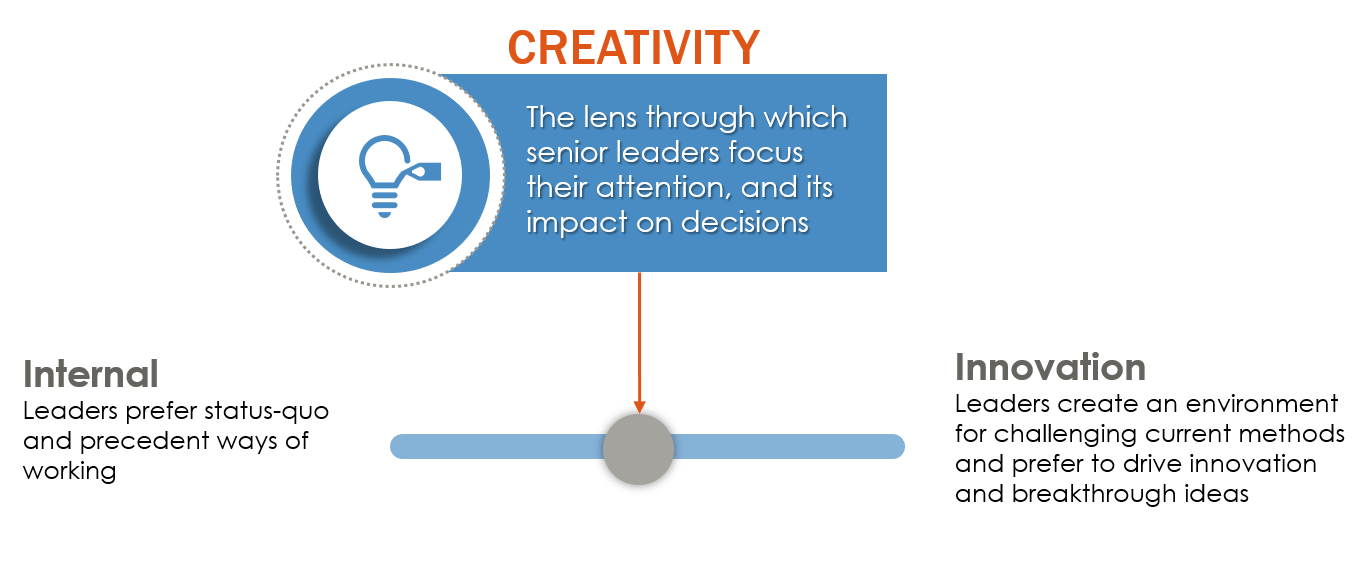Now, this may not work or be appropriate in certain paternalistic or top-down cultures. When leaders are set up to give direction, and employees are accustomed to awaiting direction, not all organizational cultures (dare I say country cultures) value this more egalitarian format. Precedent can garner confidence and safety for certain employee groups who prefer to follow protocols, past-precedent, and tried-and-true procedures. And the past always provides critical learnings. It is important to know what culture best fits your organization and will best enable your organization to achieve its vision and strategy.
The Secret 7 Culture Conversation #3 of 7: CREATIVITY
Dave Eaton, Partner at The Clarion Group, Ltd. • July 20, 2020

Imagine a culture where all ideas are welcome, even the crazy and “out of the box” ones, where employees feel safe to ask the question, “Have we ever thought about X before?” A work environment in which senior leaders create a “no idea is a dumb idea” environment such that teams come together, brainstorm new ways of looking at organization-wide problems, and create breakthrough ideas together?
Think for just a moment. If you could make just one change to the culture in your organization, what would that be?
In my experience over the last several years, the response I hear most to this question is: “I wish our organization could come up with effective new ways of working and serving our customers faster.”
I’ll share a recent example of how horizontal collaboration accelerated innovation across an entire industry. Perhaps this can be a case study for your organization? A few years back, senior leaders at an outdoors specialty retailer we were working with, were wrestling with how to better compete on “Black Friday.” In a culture where decisions normally came from the top, these leaders made a bold (for the CEO at the time) move and assembled a cross-functional team to quickly develop options, vet them, and come up with a recommendation. The team came up with many ideas, at first relying on what they had seen work in the past. “We could open our doors at midnight on Thanksgiving night.” “We could run deeper discounting than our competitors.” But as ideas begat more ideas, creativity blossomed. In the end, #optoutside became the breakthrough idea, a pace-setting innovative step that today has hundreds of retailers following their lead, all because one retailer dared to step out of their comfort zone and allow a horizontal, cross-functional team to take the challenge from senior leadership and “invent” a new way.
With the pace of technological advancement along with the continued shifting of power to the consumer, the need to move towards greater innovation seems rather obvious. However, many organizations today still consider most major decisions through a historical lens. A fixed mindset, a fixed culture, where all roads lead back through legacy processes and systems; where leadership’s general position is, “If it ain’t broke, don’t fix it!”
Interestingly, renowned Dutch social psychologist Geert Hofstede’s behavioral dimension of “High Uncertainty Avoidance” comes into play here: 80% of people do not like ambiguity, uncertainty, or change. Not surprisingly, we see senior leaders preferring to stick to what they know, what has always worked in the past, and rely on historical patterns and time-proven ways as their guideposts for any new decisions.
During the era of process re-engineering, many organizations became fixated on standardization, centralization, and control. To avoid repetition (rightfully so) in their processes and systems, they sought to be “lean” by creating standards for how things should get done around their shops. However, what that also created was a desire to always reference those proverbial manuals, or standard operating procedures, which at times, makes for a most efficient enterprise. But it also has a potential downside: creative individuals with breakthrough ideas are stymied and many become irreparably disengaged. So, while best practices should always be leveraged, looking at the marketplace and current challenges through a fresh lens often unlocks amazing ideas.
Another way to look at this is described in many training programs as “Growth Mindset” vs. “Fixed Mindset.” According to Carol Dweck, Psychologist and Stanford professor, in a fixed mindset, “students (and employees) alike believe their basic abilities, intelligence, and talents are set traits.” They adopt a mindset that you are born with a certain amount and that's all you have. She goes on to describe a great alternative: “In a growth mindset, however, students (and employees) believe their abilities and intelligence can be developed with effort, learning, and persistence. Their basic abilities are simply a starting point for their potential. They don't believe everyone is the same, but they hold onto the idea that everyone can become smarter if they try.” (Dweck, 2015)
I like to imagine what leaders can do to create an inclusive climate that promotes a “Growth Mindset” vs. a “Fixed Mindset.” Nurturing cultural behaviors like building on others’ points, becoming a learning organization (Peter Senge), considering all possibilities, using the conjunction “and” instead of “but” while facilitating or following a colleague’s previous point, and more.
In the end, high-performance cultures that express open, inclusive, additive behaviors, and are reinforced by key talent levers, i.e., effective performance management and talent development systems will see a rise in innovation potentially leading to greater results.
For more information on The Secret 7, or if you would like to receive a unique survey link (custom URL), free for your company/ organization, please click here and complete the form.
In my experience over the last several years, the response I hear most to this question is: “I wish our organization could come up with effective new ways of working and serving our customers faster.”
I’ll share a recent example of how horizontal collaboration accelerated innovation across an entire industry. Perhaps this can be a case study for your organization? A few years back, senior leaders at an outdoors specialty retailer we were working with, were wrestling with how to better compete on “Black Friday.” In a culture where decisions normally came from the top, these leaders made a bold (for the CEO at the time) move and assembled a cross-functional team to quickly develop options, vet them, and come up with a recommendation. The team came up with many ideas, at first relying on what they had seen work in the past. “We could open our doors at midnight on Thanksgiving night.” “We could run deeper discounting than our competitors.” But as ideas begat more ideas, creativity blossomed. In the end, #optoutside became the breakthrough idea, a pace-setting innovative step that today has hundreds of retailers following their lead, all because one retailer dared to step out of their comfort zone and allow a horizontal, cross-functional team to take the challenge from senior leadership and “invent” a new way.
With the pace of technological advancement along with the continued shifting of power to the consumer, the need to move towards greater innovation seems rather obvious. However, many organizations today still consider most major decisions through a historical lens. A fixed mindset, a fixed culture, where all roads lead back through legacy processes and systems; where leadership’s general position is, “If it ain’t broke, don’t fix it!”
Interestingly, renowned Dutch social psychologist Geert Hofstede’s behavioral dimension of “High Uncertainty Avoidance” comes into play here: 80% of people do not like ambiguity, uncertainty, or change. Not surprisingly, we see senior leaders preferring to stick to what they know, what has always worked in the past, and rely on historical patterns and time-proven ways as their guideposts for any new decisions.
During the era of process re-engineering, many organizations became fixated on standardization, centralization, and control. To avoid repetition (rightfully so) in their processes and systems, they sought to be “lean” by creating standards for how things should get done around their shops. However, what that also created was a desire to always reference those proverbial manuals, or standard operating procedures, which at times, makes for a most efficient enterprise. But it also has a potential downside: creative individuals with breakthrough ideas are stymied and many become irreparably disengaged. So, while best practices should always be leveraged, looking at the marketplace and current challenges through a fresh lens often unlocks amazing ideas.
Another way to look at this is described in many training programs as “Growth Mindset” vs. “Fixed Mindset.” According to Carol Dweck, Psychologist and Stanford professor, in a fixed mindset, “students (and employees) alike believe their basic abilities, intelligence, and talents are set traits.” They adopt a mindset that you are born with a certain amount and that's all you have. She goes on to describe a great alternative: “In a growth mindset, however, students (and employees) believe their abilities and intelligence can be developed with effort, learning, and persistence. Their basic abilities are simply a starting point for their potential. They don't believe everyone is the same, but they hold onto the idea that everyone can become smarter if they try.” (Dweck, 2015)
I like to imagine what leaders can do to create an inclusive climate that promotes a “Growth Mindset” vs. a “Fixed Mindset.” Nurturing cultural behaviors like building on others’ points, becoming a learning organization (Peter Senge), considering all possibilities, using the conjunction “and” instead of “but” while facilitating or following a colleague’s previous point, and more.
In the end, high-performance cultures that express open, inclusive, additive behaviors, and are reinforced by key talent levers, i.e., effective performance management and talent development systems will see a rise in innovation potentially leading to greater results.
For more information on The Secret 7, or if you would like to receive a unique survey link (custom URL), free for your company/ organization, please click here and complete the form.

We’ve seen many organizations shifting their command and control, autocratic and authoritative leadership style to one that fosters collaboration, often through taking risks, empowering their people and their teams, and welcoming the dissonance that comes from breaking down silos and allowing for horizontal, cross-functional teams to form.

In the context of organizational culture, “time” is defined as the priority people place on time vs. relationships, and in our experience, organizations that “get it right” more often than not enjoy greater success. Many clients over the years have challenged us as to whether they need to choose between the two ends of this dimension. “No, you don’t.” But you do need to know when to play each end of the culture dimension of time to get the best results.

“Naval-gazing” and “myopic” are two phrases often used to describe insular, internally focused, and inward-looking organizations. Of course, leaders must take care of their people, be empathic to the employee experience, and focus on improving and strengthening internal processes. These are all critical steps in building a high-performance organization. However, leaders also need to constantly look out ahead, anticipating customer needs, trends in the industry, and market forces that can have an impact on not only their customers, but also their relevance as a provider of certain products and services.

As the momentum of the Black Lives Matter movement continues to grow, I have been struck by how companies are responding to it. Most are openly acknowledging the unintentional complicity of their own organizations in perpetuating the issues; implicit biases are being illuminated like never before. I am impressed by how this movement that is challenging systemic (i.e., across the “ecosystem”) biases is unearthing the core of our implicit biases. The broader context from which this heightened awareness has spawned has come about, I think, from the collision of many forces that are culminating to create one giant breaking wave: confusing and divisive messages from the U.S. administration, pent up isolation and angst from COVID-19, an economy that has heightened the disparity between the “have and have nots,” positive overseas relationships with allies turning adversarial, and so much more. Metaphorically, these forces, strengthened by mass-impact movements such as Black Lives Matter, have created a huge pile of dry kindling; the death of George Floyd (following way too many others) was perhaps the spark that ignited the bonfire now burning. Companies today have three choices to make in response to the challenge so well-articulated by the Black Lives Matter movement: Do nothing, assuming “this too shall pass.” Assess, and where needed, adapt their own internal culture and operating environment in ways that surface and eliminate implicit biases. Embrace the work in choice #2 WHILE CONCURRENTLY : Developing holistic clarity around how, as a player in society, the organization is knowingly – or unknowingly – perpetuating biases, racist principles, and divisive behavior in their marketplaces; and then Making the changes needed, accepting that pillars so foundational as mission, vision, and values may be at stake. I am optimistic that the Black Lives Matter movement is going to make a difference – ideally at the systemic level but at least at a “dent” level. So many company leaders with whom we’ve worked have chosen #3 as the necessary course to follow. This is encouraging as it reflects broad recognition that the organization’s contribution to societal change requires both “inside” and “outside focus.” In our experience, working with literally hundreds of leaders, most organizations had begun the journey towards creating truly diverse and inclusive cultures some time ago; the fires now have accelerated those efforts, prompting deeper consideration into areas such as: Talent Management : How is our leadership team “mapping” (from a diversity perspective) to our customer base, employee base, and the communities we serve/operate in? Leadership Principles : Have we reviewed our leadership principles and considered development strategies/learning to ensure we are building the muscle required of our leaders to be inclusive leaders, who also stretch themselves to form diverse-by-design teams intentionally to broaden the unique perspectives brought to a business problem or opportunity? Today we see leaders and their organizations examining with real scrutiny “who they be” with their customers, partners, and shareholders: How are we selecting the market segments to do business with? Why? Do these choices harmfully exclude others from our products/services? Have we reviewed our approach to supplier management and selection and considered any implicit bias or leanings based on historical relationships only? Who do we recruit and select to represent us in the marketplace, either our employees, agents, distributors, or sales representative agencies? Are we too aggressively going after the segments where we can maximize profits or are we balancing the need to make money with the needs of all of society? How do we best reset our strategic choices on the ways we interact with the marketplace so as to not perpetuate implicit bias and exclusion? We should all applaud the companies that are pursuing this much bolder and harder path. It is not lipstick on the pig; it is holistic and systemic change. It will take years of concerted effort, millions of dollars, and great courage to stay the course to fully operationalize the principles of diversity, equity, and inclusion. Patience is needed but inaction is unacceptable. For the companies being heralded, we should expect to see steps of progress while always remembering that lasting systemic change will take time.

In response to the human emotions around coping with COVID-19, the Harvard Business Review (HBR) recently published an interview* with David Kessler, a globally respected expert on the stages of emotional response when confronting negatively perceived change (ultimately, death) initially formulated by Elizabeth Kubler-Ross. (Clarion founder and my partner, Bill McKendree, published a good piece last week on this: Times of Crisis Call for Leadership Heart ). With Kubler-Ross’ family’s agreement, Kessler postulated the presence of a sixth and final stage beyond acceptance – finding meaning. I think that finding meaning in the face of such loss of human life and economic devastation crosses over into a profoundly human spiritual dimension. That HBR would have the courage to enter that dimension is somewhat astonishing. But it is also an accurate and insightful acknowledgement that COVID-19 has erased any artificial boundaries between business and humanity. It is a door opened that I now walk through cautiously. It seems obvious that in past times we would have looked to spiritual leaders for the kind of guidance sought in the face of grief, death and dying. Here, now, in the face of a global pandemic, the stage for spiritual leadership feels very, very empty. Sadly, the divisiveness that rips across a complicated mixture of ethnic groups and religious sects, clinging to seemingly irrelevant historical and political conflicts, undermines the ability of any one religiously affiliated person to represent us all, to speak to us individually, to touch our hearts directly. How then do we find even the slightest thread of meaning that is in fact by its very nature fundamentally spiritual, but does not say so in a way that alienates any one of our fellow employees? Or our customers? Our neighbors? Our friends? Perhaps it is just me, but there is something about the nature of COVID-19 that I cannot help but feel is speaking to us all, collectively, in a single, unifying voice. We are all human. We are all vulnerable. We are all able to help. We are all in this together. Right now , that alone is meaningful. If a virus can view us this way, why can we not view ourselves this way? Our survival may depend upon it, and yet we remain stuck in our separateness. We are our own worst enemies. If it helps, then see this “meaning” as coming from a purely scientific view, not a religious view. At one level it is more important that we just see it. But truth be told, it is not one or the other. As seen by a scientist, it is both:

Leaders today are being asked to step up to a challenge few ever imagined. There simply is no playbook for leading through COVID-19. Carefully crafted strategic plans have suddenly become irrelevant, and leadership teams across the globe have moved into aggressive downsizing in anticipation of an unprecedented economic slowdown. We’ve talked to a lot of our clients over the past week. The block and tackle of re-forecasting is well underway, but most are privately feeling alone and simply unsure of how to approach the “soft side of business” – keeping employees settled and engaged. Times of crisis call for heart. And heart starts with understanding how employees’ needs have changed; for many, needs have changed dramatically. With the “silent enemy” now among us, the cadence of life has been significantly altered: work-from-home, children out of school, elderly parents to care for, and illnesses to manage, often while we are trying to come to terms with the real financial impact many are experiencing. Leaders, consider this: in a crisis, humans revert down Maslow’s Hierarchy of Needs, focusing on the basics: safety, security and health. Project deliverables, reports, and even the economic viability of the organization will for most take a backseat to individual concern for personal and family well-being and financial security.






